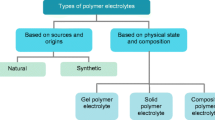Abstract
Polymer blend electrolytes based on poly(ethylene oxide) (PEO) and poly(vinylidene fluoride-hexafluoropropylene) (PVdF-HFP) were prepared by using different lithium salts LiX (X = ClO4, BF4, CF3SO3, and N [CF3SO2]2) using solution casting technique. To confirm the structure and complexation of the electrolyte films, the prepared electrolytes were subjected to X-ray diffraction (XRD) and Fourier transform infrared spectroscopy (FTIR) analysis. Alternating current (AC) impedance analysis was performed for all the electrolyte samples at various temperatures from 303 to 343 K. The result suggests that among the various lithium salts, LiN[CF3SO2]2-based electrolytes exhibited the highest ionic conductivity at 8.20 × 10−4 S/cm. The linear variation of the ionic conductivity of the polymer electrolytes with increasing temperature suggests the Arrhenius-type thermally activated process. Activation energies were found to decrease when doping with lithium imide salt. The dielectric behavior has been analyzed using dielectric permittivity (ε*), electric modulus (M*), and dissipation factor (tanδ) of the samples. Cyclic voltammetry has been performed for the electrolyte films to study their cyclability and reversibility. Thermogravimetric and differential thermal analysis (TG/DTA) was used to ascertain the thermal stability of the electrolytes, and the porous nature of the electrolytes was identified using scanning electron microscopy via ion hopping conduction. Surface morphology of the sample having maximum conductivity was studied by an atomic force microscope (AFM).












Similar content being viewed by others
References
Nunes-Pereira J et al. (2015) J. Power Sources 281:378
Angulakshmi N, Manuel Stephan M (2014) Electrochim Acta 127:167
Gong C et al. (2014) J power sources 246:260
Starkey SR, French R (1997) Electrochim Acta 42:471
Rand DAJ (1979) J Power Sources 4:101
Joykumarsingh I, Bhat SV (2004) J Power Sources 129:280
Johansson P (2001) Polymer 42:4367
Munshi MZA, Owens BB (1988) Solid State Ionics 26:41
Gilies JRM et al. (1987) Polymer 28:1977
Malik P et al. (2006) Polym Degrad Stabil 91:634
Carols M, Costa A, et al. (2013) RSC Adv 3:11404
Xue Z et al. (2015) J Mater Chem A 3:19218
Pradeepa P et al. (2015) Chinese Chem Lett 26:1191
Liu Z et al. (2015) Coordin Chem Rev 292:56
Rajendran S et al. (2004) Solid State Ionics 167:335
Nowinski JL et al. (1994) J Mater Chem 4(10):1579
Hodge RM et al. (1996) Polymer 37:1371
Papke BL et al. (1982) J Electrochem Soc 129:1434
Kesavan K et al. (2014) Polymer Science Ser B 56:520
Ulaganathan M et al. (2011) J Mater Chem Phys 129:471
Stephan AM et al. (1999) J Power Sources 81:752
Pradeepa P, Ramesh Prabhu M (2015) Int J Chem Tech Res 7(4):2077
Jacob MME, Arof AK (2000) Electrochim Acta 45:1701
Chintapalli S, French R (1998) Electrochim Acta 43:1395
Roy I et al. (1998) J Phys Chem A 102:3249
Xu K (2004) Chem Rev 104:4303
Capiglia C et al. (2000) Electrochim Acta 45:1341
Xu JJ, Ye H (2005) Electrochem Commun 7:829
Niitani T et al. (2009) J Electrochem Soc 156:A577
Ali AMM et al. (2007) Mater Lett 61:2026
Abraham KM, Alamgir M (1993) J Power Sources 43:195
Quartarone E et al. (1998) Solid State Ionics 110:14
Jiang G et al. (2005) J Power Sources 141:143
Fan LZ et al. (2007) Adv Funct Mater 17:2800
Saito Y et al. (2002) J Phys Chem B 106:7200
Lalia B et al. (2013) J Solid State Electrochem 17:575
Li M et al. (2011) J Power Sources 196:3355
Fan L et al. (2002) Electrochim Acta 48:205
Costa CM (2014) J Power Sources 245:779
Zhu W et al. (2001) J Polym Sci Part B 39:1246
Immanual Selvaraj I et al. (1995) J Electrochem Soc:142
Stephan AM et al. (2002) Solid State Ionics 148:467
Armstrong RD, Race WP (1976) J Electroanal Chem 74:125
Singh KP, Gupta PN (1998) Eur Polym J 34:1023
Suzhu YU et al. (2000) J Appl Physics 88:398
Simmons JG et al. (1970) J Appl Physics 41:538
Ping P et al. (2010) C Chem J Electrochem Soc 11:157
Lu Z et al. (2006) J Power Sources 156:555
Aurbach D et al. (1991) J Electroanal Chem Interfacial Electrochem 297:225
Acknowledgments
The author P. Pradeepa gratefully acknowledges the UGC-BSR, New Delhi, India, for the financial support to carry out this work.
Author information
Authors and Affiliations
Corresponding author
Rights and permissions
About this article
Cite this article
Prabakaran, P., Manimuthu, R.P. Enhancement of the electrochemical properties with the effect of alkali metal systems on PEO/PVdF-HFP complex polymer electrolytes. Ionics 22, 827–839 (2016). https://doi.org/10.1007/s11581-015-1618-5
Received:
Revised:
Accepted:
Published:
Issue Date:
DOI: https://doi.org/10.1007/s11581-015-1618-5




